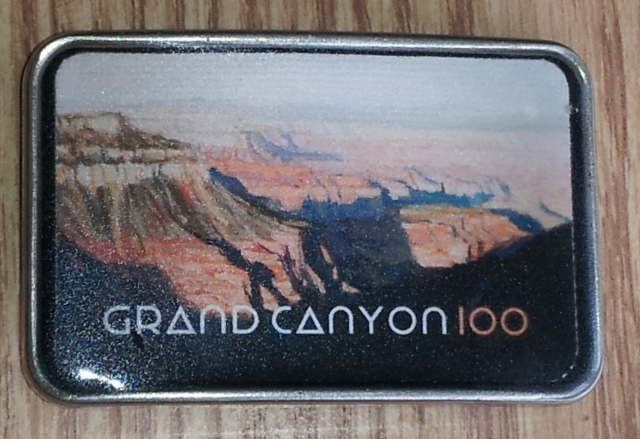 The Grand Canyon certainly needs no introduction. It is one of my favorite places to run. I’ve run more than 1,000 miles in and along the canyon and I jumped at the chance to run an official 100-mile race along the North Rim. As tourists visit the North Rim, it is common to feel some disappointment at the views as compared to the South Rim. From the South Rim you can view the canyon from many points but from the North Rim, in the National Park, you really just have one view from paved roads. But the Grand Canyon 100 took us to spectacular viewpoints outside the park, that tourists miss and opened my eyes to a section of the canyon I had never seen before.
The Grand Canyon certainly needs no introduction. It is one of my favorite places to run. I’ve run more than 1,000 miles in and along the canyon and I jumped at the chance to run an official 100-mile race along the North Rim. As tourists visit the North Rim, it is common to feel some disappointment at the views as compared to the South Rim. From the South Rim you can view the canyon from many points but from the North Rim, in the National Park, you really just have one view from paved roads. But the Grand Canyon 100 took us to spectacular viewpoints outside the park, that tourists miss and opened my eyes to a section of the canyon I had never seen before.
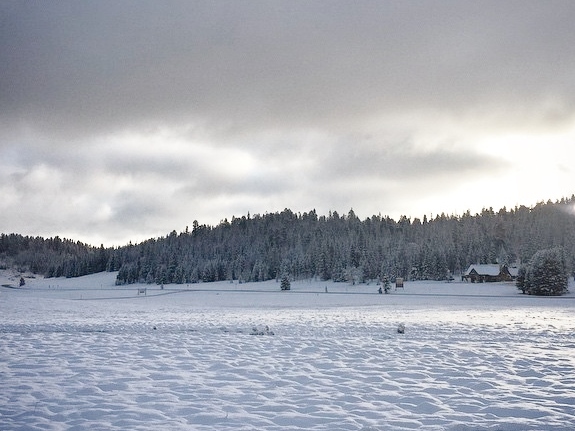
Race headquarters was established at Kaibab Lodge, just outside the National Park. Not only would there be a 100-mile race, but also distances of 50-miles, 50K, and 25K. I went down a day early but because of poor weather I spent the morning before running along the rim above the town of Kanab. I don’t usually do a long run the day before a race but I couldn’t resist a random 18-mile adventure run exploring trails in southern Utah that I had never run on before. During the afternoon I rested, visited the start/finish area, and prepared for the long race the next day. A couple inches of snow had fallen on the highest portions of the course with more on the way, and I was glad that I brought plenty warm clothes. I usually don’t put much in my drop bags but I prepared three large bags with many clothes options to make sure I didn’t fall victim to being stopped because of the weather.
I returned to my room in Kanab and in the early morning I drove again the 62 miles to the start. Everything was blanketed in up to six inches of snow and it was 25 degrees. I wisely decided to dress in long sleeves and long tights which normally I do not do at the beginning of the race. But my warm attire remained on me for the entire race as temperatures never seemed to get much above the 30s.
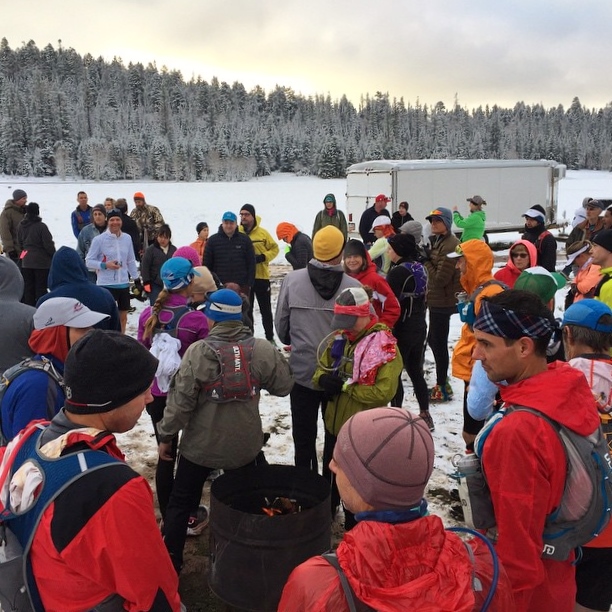
At 6:00 a.m. about 100 of us started our epic run. About half planned to run 100 miles and the other half 50 miles. For the first 16 miles we ran west through the forest to reach a portion of the North Rim that faces west. We initially climbed toward the high point of the Kaibab Plateau to about 9,170 feet.
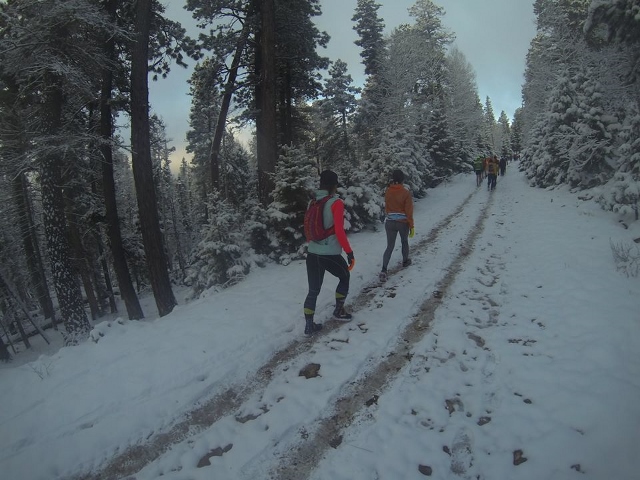
Yes, we were running in snow, mostly on ATV or 4WD roads. The frontrunners pounded down the snow a bit making it easier for those who followed. I had no desire to be near the front and knew that I couldn’t keep up with those speedy guys anyway. I was content to plow along in the snow and hoped that we didn’t have too many miles of it. It reminded me of the many miles of sand I ran in at Antelope Canyon 100 and Monument Valley 100. I never expected to have a similar sand experience here.
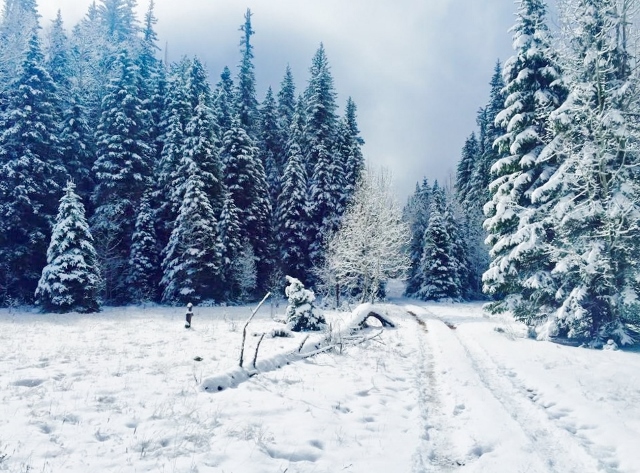
After reaching the high point, it was mostly all downhill for the next 14 miles descending through forest and snow-covered meadows to the North Rim height of about 7,700 feet. The challenge was to keep the speed up in the snow tracks. Occasionally we would turn onto a muddy dirt road to really slow things down, but usually we were just trying to keep good footing in a narrow track pounded into the snow.
I reached Dry Park Lakes aid station (mile 5.1) at 0:58 and Squaw Canyon (mile 8.3) at 1:40. (The advertised mileage for the aid stations and the course in general was pretty far off. My GPS would show the 100-mile course to be around 94.5 miles and I trust that to be pretty close. In my write-up, I use the GPS miles).
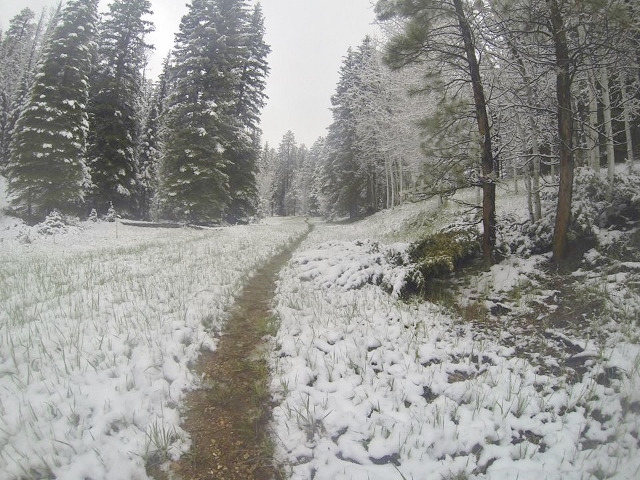
From this point, things got very fun. The trail turned into single track and as we continued to descend, the snow became less deep and faster to run in. I was having a blast, feeling great, pushing the pace, singing at times, and even letting out shouts of joy. We spilled out onto a dirt road which we ascended to Stina aid station (mile 13.3), arriving at 2:29. Everything was chaos there. The aid station wasn’t set up, the drop bags weren’t there and there was no food, only water. This was distressing because we would hit this point three times and it should have my main drop bag items there. But the aid station captain had taken a wrong turn getting there and got stuck in the snow. This basically meant that there would be no aid for me, except water, for a 19-mile stretch! I was glad that my pockets were still stuffed with food items, but no doubt this had a significant impact on my intake.
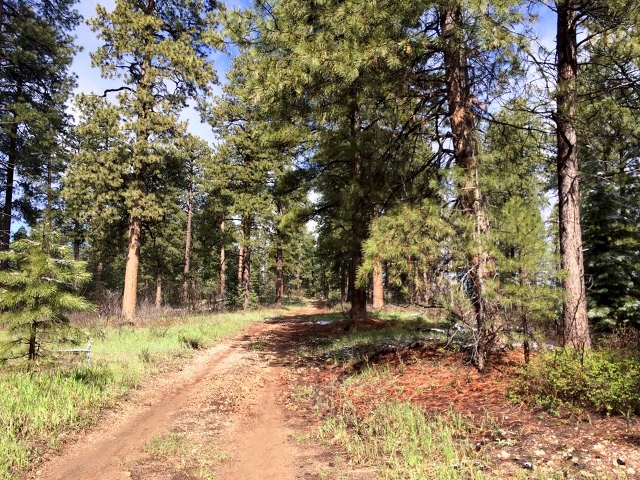
Now at 8,000 feet, the snow was mostly gone and we ran toward our first view of the Grand Canyon at Stina Point. The route took on forest roads and then winding through some trees to the rim.
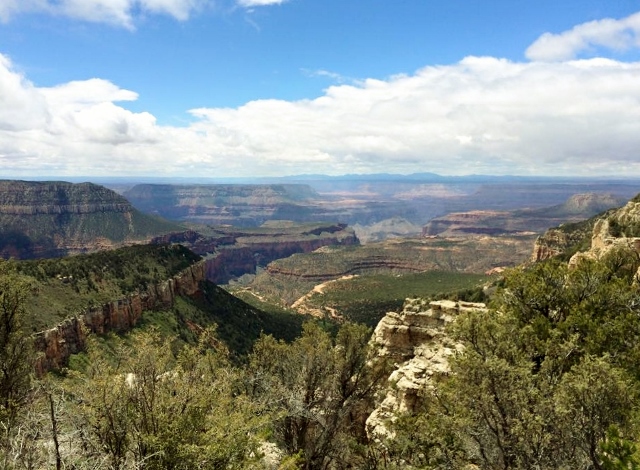
We eventually had a clear view of the impressive canyon. It was a limited view, but still the Grand Canyon. I paused, took it all in, and then continued on my way. I was back at Stina aid (mile 19.9) at 4:01. The aid station was still in confusion but I sat down for the first time and did some feet adjustments to solve a hot spot. After a 5-minute break I was on my way.

Next up was Timp and North Timp Points. Matt and Pete Van Horn drove by and offered me a ride. I almost took up their offer but continued on. I soon was on the impressive Rainbow Rim Trail, a 19-mile rolling single track along the rim that would visit five viewpoints. The single track boosted my spirits and put a spring in my step.

I reached North Timp Point (mile 27.4) at 5:39. I knew overall my pace had been slow, but I was running in about 12th place and my pace was steady. Along the Rainbow Rim Trail, for most of the miles we were in forest with no views of the canyon. But I noticed a similar pattern along the way. When the wind started to pick up, I knew we were approaching the rim edge and then spectacular views would be presented. Sadly, the sun rarely came out at all and usually gloomy clouds covered us all day. Rain would at times sprinkle but not last very long.
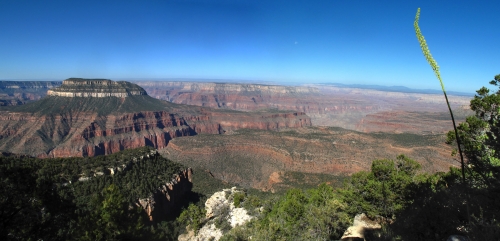
I reached Fence Point (mile 36.9) at 7:52 and took an 8-minute break, switching out a shoe and using my drop bag. Next up was Parisawampits Point (mile 42.7) at 9:20. This aid station was captained by the same young couple attending Southern Utah University, who had captained aid stations and Antelope Canyon and Monument Valley. They are always so kind and attentive to me, and best of all cheer me up with their youthful enthusiasm. Running long distances at times can get quite lonely as runners spread out and cheerful help makes a huge difference.
Another runner complimented me, that I was still able to run the uphills. He said he would have to walk the uphills the rest of the way. I didn’t boast, but I knew that I would be able to continue to run the uphills until the finish as long as my feet were fine. I knew that many runners had burned themselves out during the morning snow section. I held back and was feeling fine.
At this aid station, I heard another runner ask if the next section was very technical. I chuckled thinking he had thought previous sections had been hard. So far the trail was very easy technically compared to Wasatch Mountain trails. But then the joke was on me. The next section was pretty brutal. Gone was the nice rolling single track. In its place was a cruel route that went steeply down and up drainages without using any switch backs. It was a huge surprise to me. “What is this?” I said out loud. But I pushed the pace and stretched a big lead on runners behind. Soon the route became what seemed like a feint deer trail, but it actually was an established trail which had probably seen better years. As thorny bushes grabbed my pants, flashing into my mind was: Barkley. Surely this section was similar to a Barkley experience, the toughest 100-mile race in the world. After descending a crazy steep route, with many flags to keep you on course, I thankfully reached a kind dirt road. Despite the difficulty of that section, I really enjoyed the challenge and the changeup it presented.
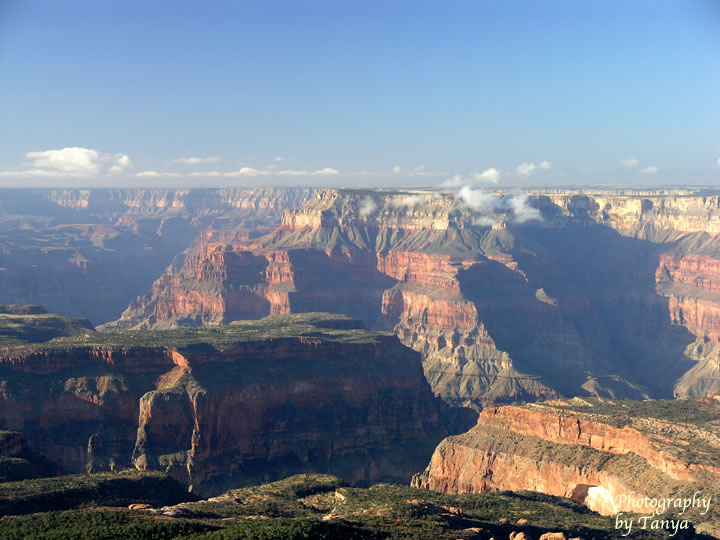
I climbed up to Crazy Jug (mile 47.6) at 10:56. The volunteers said we were about at mile 50, but I knew that was wrong and that the course was short. But I wasn’t complaining. Matt and Pete Van Horn were there making wise cracks. They drove on ahead to prepare to film me at Monument Point.
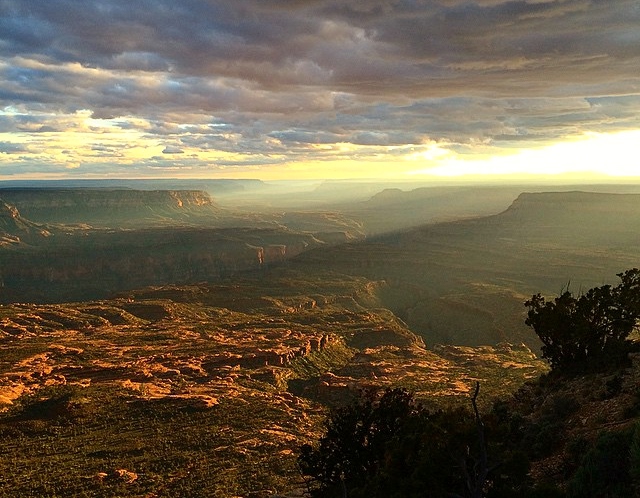
Monument Point was spectacular. This is a tourist destination and for the first time I did share the trail with people who weren’t part of the race. This location was the turnaround point. As I approached to turnaround, Pete screamed through the trees that I was approaching and told me to slow down. I then got the cue to run fast with Matt’s drone flying over my head. It was great fun to put a show on for the camera and I was thrilled to reach the turnaround and the specular views. I paused to talk with the Van Horns and then went on my way, heading back.
Now my focus was to run fast enough to get through most of the “Barkley” section before dark. I returned to Crazy Jug (mile 53.5) at 12:32 (6:32 p.m.) and knew I had an hour of light left. It was great to greet runners on the way back and seen the effects that the “Barkley” section was having on them. Many pleaded with me, asking me how much further it was. I could not resist laughing. I was able to determine that I was running in 8th place. The runner ahead of me had a good lead of about two miles and I was leading a group of about five runners who were within about 1-2 miles of me. It was easy to stay ahead of them and I hoped that would continue.
I made it through the most confusing “Barkley” section before dark, made good time, and arrived back at Parisawampits (mile 58.4) at 14:13. I took a five minute break but quickly left because a runner behind me arrived. My aid station stops were faster than the runners behind so each time I could extend a good lead.
I was keeping warm and my pace in the evening still caused me to sweat. Around my waist was wrapped a jacket that would go on and off, also gloves and hat. I had everything I needed without hauling the heavy-looking day packs that some runners carried. I just couldn’t understand how they could tolerate those.
I rolled into Fence (mile 64.2) at 15:55 (9:55 p.m.). There, I took my longest stop thus far, 23 minutes. I was starting to feel somewhat thrashed. I rested, fixed my feet with clean socks, and tried to eat well. I put on another layer as it was getting colder (close to freezing) and pushed on. For the next couple miles, I kept pushed ahead of a runner’s light. But by 11 p.m. my race fell apart.
Again, my stomach shut down, felt terrible, and wouldn’t let me run fast. When this happens, my respiration and heart rate also go up. Eventually I had to stop, sit, and calm down my system. The other runner caught up. I jumped up and sprinted past him up a hill, but that didn’t last long and soon I was going slowly and he went on by. I still had about six miles to the next aid station. My pace slowed to 22-minute pace. As I slowed, I became cold. I put on all my layers, four of them, but was still cold. How could I deal with this for the next two hours? I tried my best to eat what I had and threw up several times. I became colder and drowsy and knew that hyperthermia was starting to arrive. I pushed on, knowing that I had to continue on, but I was in a lot of agony. I was convinced that I would DNF at the next aid station and went through my mind all the good reasons why I needed to quit. I had been pretty sick with bronchitis just a few days earlier and certainly that was affecting my oxygen intake. I had tried my best, it was smart to quit.
Finally the North Timp aid station came into view (mile 73.7). I arrived at 19:40 (1:40 a.m.). DJ was the aid station captain for the night and he did his best to help. I sat in front of a propane heater or lay down in a cot. But I couldn’t get warm and groaned as my stomach rebelled. I knew the next section was another long 8.5 miles and that I couldn’t face that in the shape I was in. Eventually other runners arrived, staying long. One time I went out of the big tent to throw up and when I returned a guy had taken my seat in front of the heater. I didn’t say a thing, sat in another chair and shivered like crazy away from the heat. Finally after about ten minutes, his pacer noticed my stuff next to his chair. I admitted that the runner had taken my place and asked if we could switch places. He did. Still I couldn’t get warm enough. Dennis Ahern arrived. I had been about three miles ahead of him and at times more than an hour. I really wanted to get up and continue on with him, but when I stood up, I knew that wasn’t possible. My sickness continued. It was now 3:00 a.m. and I had been at the aid station for 1:20.
Eventually, I asked DJ if I could sit in his car with the heat on. He cheerfully said that would be fine and set up things for me. It took about ten minutes for the heat to really get going but it started to help. I contemplated why I have this problem in so many races. The common factors seem to be: My age, altitude (not enough oxygen), cold weather, and calorie/electrolyte imbalance. Deep breathing helps the stomach, but I had really concentrated on that, and it eventually didn’t help. Oxygen-rich blood is drawn away from the stomach and I start suffering.
Soon I dozed off. When I awoke after being at the aid station for two hours, I felt much better. My core body temperature was back up and I was hungry, ready to eat again. By 4:00 a.m. after being at North Timp for 2:40, I was ready to go again. I thanked DJ for all his help. Never at any time did he suggest that I quit.
Now, back in focus, I thought about those runners in front of me. Could I catch some? I started off at a careful pace with the stomach still tender. My pace kept improving and soon I was cruising faster than 12:00 pace. I was warm and even took of my gloves for a time. I passed a runner and hoped there would be more ahead.
I arrived back at Stina (mile 81.2) at 24:12. It was now morning, dawn had arrived. When I sat down, I felt terrible again. I rested, ate, confident that I could again recover. I did, but it took 30 minutes. Back on the trail I knew it was mostly uphill to the finish. I knew the course was short and that I actually only had 13.3 miles left. The snow from the previous day was mostly gone now and it was good footing until the glorious sun came out and melted the mud. At one point I became drowsy and couldn’t resist. I lied down in a sunny meadow of grass and spent five minutes just resting and feeling the warmth of the sun.
I kept feeling better and could easily keep a steady run up the hill. With about 7 miles to go, I was ready to race again and push the pace very hard, seeing if I could catch anyone. But I was disappointed. Around every turn was another long stretch without anyone in sight. I reached the final aid station (mile 89.4) at 27:23. They had greasy bacon and greasy fried potatoes. Those were the best and exactly what my system needed. After eating that, it felt like my jets were turned on and I started running like crazy. It was great fun and I was very disappointed that the course would soon end. Finally I was running at full speed again but soon it would be over.
At the high-point of the course, I passed a runner who was walking, surprised to see me, but I ran on fast ahead. Down the 1.3 miles to the finish, I cruised at speeds faster than 8:00 pace. There were no more runners to catch, the next one had finished 30 minutes earlier.
The end came into sight and I finished in 28:38:58. I was in great spirits. Despite my challenges, I had finished! It was my 69th 100-mile finish and my 6th for 2015. I was amazed that I didn’t feel any sore muscles, no sore feet, and had a feeling a disappointment that the race was over. I had finished in 15th place, so lost seven positions because of my stomach problems. Looking over my split times, I spent a total of about 4 hours in the aid stations. It was unavoidable and surprising that I had overcome and continued, still finishing well.
What can I do to solve this frequent problem? I have ideas and the primary focus will continue to be eating better as evenings approach during a race. I need to do more solid foods and change things up. Slowing down obviously helps, but I like to push my limits. I have one of those oxygen sensors and next race I take that with me and monitor things. Staying warm is always key. So I will keep trying and keep learning.
Grand Canyon 100 is now one of my favorite 100-mile races. I’ll return.



